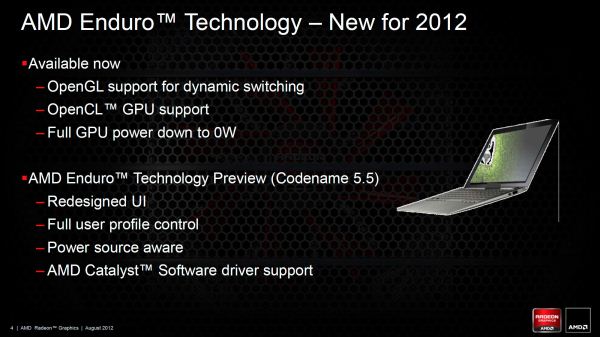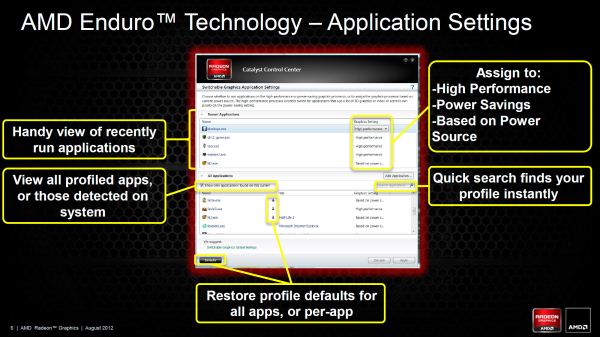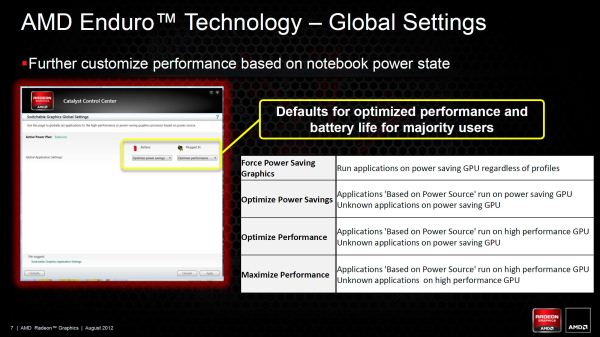AMD’s Enduro Switchable Graphics Levels Up
by Jarred Walton on September 6, 2012 3:00 AM ESTNew for Mid-2012: “Enduro 5.5” Enhancements
When AMD created the Enduro brand, they were really almost where we wanted them. They had dynamic switching with support for most of the latest games and applications, and when it worked properly it would be difficult to tell if you were using an NVIDIA or an AMD dGPU. The problem was when things didn’t work and you had to go into the drivers, and there were several problems. OpenGL support was totally out, many of the latest games were also missing default profiles (and sometimes wouldn’t let you properly specify the correct GPU), the UI was obtrusive and sometimes hard to use (particularly for power users), and the drivers were dictated by the laptop manufacturers and were usually months old at launch and never updated.
While the UI seems like a minor thing to fix—I would have thought one or two months to improve the UI would have been sufficient—at least prior to the forthcoming update it remained largely unchanged. The lack of AMD-provided driver updates was really the major issue, because everything else could potentially be fixed with new drivers and you would never know. The other areas like OpenGL/OpenCL and support for various games/applications should improve over time as well, provided you can get drivers. That brings us to the upcoming Enduro release, scheduled to come out sometime this month or next. Officially it’s still just Enduro, but to help differentiate between the previous Enduro release and the upcoming release we’ll sometimes refer to the new version as “Enduro 5.5”.
The biggest news with the latest iteration of Enduro is that AMD is planning to make universal reference drivers available for all the Enduro laptops. It’s not clear precisely what that means, but potentially any laptop with Dynamic Switchable Graphics or later (e.g. PX4.0 and later) would be supported by AMD’s “reference” drivers. That’s huge, and if AMD can deliver it will assuage most of our concerns with their hardware/software. Hopefully none of the OEMs get bent out of shape or refuse to allow support, which is a problem we've seen in the past. We should see the first public release in the next month or two, and then another release somewhere in the November/December timeframe.
Besides the availability of driver updates, the UI also receives a much needed overhaul, providing both regular and power users all the options they’re likely to need as far as control of graphics switching is concerned. Open up the switchable graphics options and the top section remains largely the same, but the bottom now allows you to see all application profiles (or just the profiles for detected applications). There’s also a quick search option that works both on executable name and application/game name (e.g. HL2.exe or Half-Life 2 will both find the profile for Half-Life 2). From either list (recently used apps up top, or all apps at the bottom), you can set the GPU profile.
Where previously there were two settings (three if you count “Not Assigned”), there are now three options. As before, “Power saving” sets an application to run on the integrated graphics while “High performance” sets an application to run on the discrete GPU. The new third option is “Based on power source”, which does precisely what you’d expect: plug the laptop in and the apps with this setting will run on the discrete GPU; switch to battery power and they’ll run on the integrated graphics. For many users, everything could default to “Based on power source” and they would be happy, but certainly there will be times where you’re running on battery power but still want to use the dGPU and the drivers give you that option. Should things get squirrelly, you can also reset applications individually or globally to their default settings. It’s worth noting that the power state aware setting is something that NVIDIA currently does not implement, requiring manual intervention if you wish to override your normal settings—though how often people are using apps that require the dGPU while on battery power is something we could debate.
Besides the individual application profiles, AMD is also adding a new area to their drivers: Switchable Graphics Global Settings. This is something you could sort of get before with some laptops, but previously it involved changing from Dynamic Switchable Graphics to manual switching (i.e. switching based on power source) and then forcing the laptop into High Performance or Power Saving mode if you wanted to be low power while plugged in or high power while unplugged. That was clunky and at least in the case of the Sony VAIO C we tested it caused flickering similar to the old switchable graphics, with the dGPU drivers getting unloaded and iGPU drivers getting loaded (or vice versa), with some work behind the scenes copying context from one GPU to the other. It worked but it wasn’t elegant; perhaps more importantly, Microsoft doesn’t want anyone doing this with Windows 8 and thus new laptops won’t be able to get a Windows 8 sticker if they use this method of switching (which basically means no new laptops will do this). To make up for the loss of this functionality (which some people still prefer), AMD has added a new global settings section.
Unlike the individual application profiles, the global settings gives you four options each for Battery and Plugged In. The top two options are similar in most cases and will generally run most applications on the iGPU, and the same goes for the bottom two modes where you’ll run most apps on the dGPU. The difference is that “Force Power Saving GPU” will run all applications (regardless of what the custom profile says) on the iGPU, essentially disabling the dGPU completely. “Optimize Power Savings” in contrast will run all unknown or “Based on power source” applications on the iGPU while respecting the application profiles where they exist. “Optimize Performance” is sort of the reverse of that, running all “Based on power source” applications on the dGPU while leaving unknown applications on the iGPU. Finally, the “Maximize Performance” option runs all unknown and “Based on power source” applications on the dGPU—but applications specifically set to use the iGPU will continue to do so.
The reason for that last discrepancy (e.g. why you can’t simply run everything on the dGPU and forget about the iGPU) is that certain tools have to run on the iGPU. Intel’s drivers are one example—loading those up on the dGPU would cause problems. Intel’s WiDi is the only other I could find on my particular Clevo notebook. We were told that some of the laptop utilities like an overlay showing percentage of brightness, volume, etc. may also need to run on the iGPU. Besides the few applications that have to run on the iGPU, any applications that are set to Power Saving will continue to use the iGPU—and this makes sense as there are a lot of applications that can be set to run on iGPU/dGPU that have no need of higher performance GPU options (several anti-virus utilities come to mind, where they're starting to create a 3D context for their UI). The net result is that other than a few specific applications where the profile will exist and be locked to the iGPU, with no option to change to dGPU, everything else that uses higher function graphics can be customized to run on a specific GPU, but if you set something to iGPU presumably you want it to always run there—otherwise you would use the “Based on power source” setting.
A full set of screenshots from all the driver screens is available in the gallery below if you’re interested.
One final topic worth discussing is Windows 8. Certainly there are owners of existing laptops with switchable graphics that are wondering if they can upgrade to Windows 8 and what will happen. We’ll have to see how this actually plays out, but it sounds like the earlier versions of PowerXpress (3.0 and earlier) will probably get support with one driver bundled with Windows 8, and that may be it—but there’s always the possibility for the laptop OEMs to release their own updates, or for AMD to roll out additional drivers for older laptops. The potential for PowerXpress 4.0 and later laptops to get regular driver updates (for Windows Vista/7/8) is there, but until we actually start seeing public driver releases AMD hasn’t fully committed to supporting all of those laptops.



















200 Comments
View All Comments
Montage - Thursday, September 6, 2012 - link
So you mean the APUs can currently max Battlefield 3 and Crysis 2? How about Civ5 or Total War Shogun 2? Them APUs still got a long way to catch up with dGPUs.sirizak - Thursday, September 6, 2012 - link
Yeah this is rubbish, APU's are not going to be upto the task in a true gaming laptop for a long time yet. This is not an APU kit, at $2000+ it should give desktops a run for their money.arcticjoe - Thursday, September 6, 2012 - link
as Montage have said, there AMD's apus are very far behind in performance compared to current laptops with switchable graphics.silverblue - Thursday, September 6, 2012 - link
I'm not sure what Beenthere is smoking, but APUs are only meant to replace low to mainstream dGPUs. They're hardly a performance option. An APU-based system should reduce cost and power consumption but it's not the messiah for the more serious gamer.There will always be somebody who wants the latest and greatest, and if NVIDIA can provide the support for this, why can't AMD?
JarredWalton - Thursday, September 6, 2012 - link
It's Beenthere guys. Go read his other pro-AMD, anti-Intel comment on Ivy Bridge and Trinity mobile articles if you don't know why he's not worth feeding. ;-)hulawafu77 - Thursday, September 6, 2012 - link
AMD's APU is a pitiful solution compared to Intel Ivey Bridge + Nvidia 680M. Your suggestion is not even remotely comparable. Not even in the same stadium for performance.hmoobphajej - Thursday, September 6, 2012 - link
Their APU isn't suppose to be a solution to discrete CPU + GPU. They're a all around solution to mobility that offers a adequate performance for computation and graphics. They're for the main stream users that don't want to play BF3 on ultra or any other demanding games in particular. The APUs are more or less aimed at what mainstream buyers would want; which is a computer for daily use, good battery life, smaller form factor, and a cheaper price. Not somehting a enthusiast gamer would want... which is a desktop.sirizak - Thursday, September 6, 2012 - link
I've been following this for awhile now, I almost bought a 7970m gpu'd P150EM a month ago due to the pricing vs the 680m. I am still waiting to purchase this laptop. In Australia I can get one specced with 7970m for under $2000, GTX 680m is $2300, I have told lovely that I will come in under $2000.Until this the Enduro under utilization issue is resolved I will not buy this laptop, it is that simple. Otherwise it ticks all my boxes, quality matte screen, backlit keyboard, plenty of CPU and SSD choices, and an unobtrusive exterior. I believe there may also be issues with the headphone outputs of the P150EM. Thats not AMDs issue but another cross against this setup.
This is not cheap kit, if you cannot get this sorted please pull the product, it's a disgrace and ruining not only AMDs reputation but also the reputation of all the Clevo resellers. ie. Metabox in Oz, Sager in the US.
These machines are hitting a sweet spot on the price vs performance scale, it's a shame I can't justify spending my hard earned dollars on something that is inherently faulty.
Disclosure: I currently run a Xfire 5870 setup on my desktop, but AMD's performance here is forcing me to reconsider my GPU vendor going forward.
TokamakH3 - Friday, September 7, 2012 - link
Don't buy the 7970m. Especially not on a Clevo. I do place some of the blame on them as most of the other gaming laptop manufacturers recognized this problem and installed the ability to disable Enduro in the bios, boosting performance by as much as 50%. Clevo did not.Vozier - Thursday, September 6, 2012 - link
Hi all,first of all there some lads wich understandably are pretty mad with AMD and its 7970 product. I wont tell them to cool down, because they have been struggling with the issue for too long and even if a solution comes up now it will be already a bit late, since 1 year in computer hardware is upgrade time anyway...
That said i have recently bought a clevo P150 EM with 7970M. Not being a hardcore gamer and never having bought a gaming laptop before i am prepared to be dazzled, even with all the issues stated, but mainly because of my comparison point...
I do support and hope enduro fixes the main issues it has, mostly GPU underutilization %s when unwanted.
Would it be so hard to fix 100% GPU utilization under catalyst?
I say this because the whole issue seems to be caused by enduro's "best intentions" to optimize power usage, but failing big in doing so without affecting gameplay (ultimately FPS).
Its very clear the 7970M is mismanaged by enduro when testing games in alienware (that can shut enduro off), so it aint so har to think this could be fixed somehow.
The 7970M CAN perform, and DOES perform better that GTX 680M, when enduro is shut down, at least that gives everyone hope.
I do think this article isnt AMD biased, it does fail in meassuring GPU utilization (%GPU usage in game tests) as done by many affected users to prove and show the MAIN problem, i hope this will be included in the promised game tests.
It gives me at least hope because it clearly states AMD IS AWARE of the issues, and working to fix them...
It also gives me hope to see the issue in mainly a driver issue.
i quote:
"The biggest news with the latest iteration of Enduro is that AMD is planning to make universal reference drivers available for all the Enduro laptops. It’s not clear precisely what that means, but potentially any laptop with Dynamic Switchable Graphics or later (e.g. PX4.0 and later) would be supported by AMD’s “reference” drivers. That’s huge, and if AMD can deliver it will assuage most of our concerns with their hardware/software. Hopefully none of the OEMs get bent out of shape or refuse to allow support, which is a problem we've seen in the past. We should see the first public release in the next month or two, and then another release somewhere in the November/December timeframe."
good article!
Voz